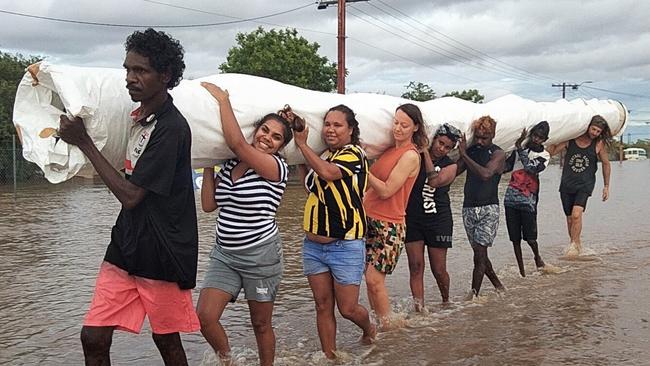Fitzroy Crossing locals rescue historic artwork from flood threat
Evacuation efforts across the flood-ravaged Kimberley region are slowly ramping up as the scale of the disaster and the size of the region continue to complicate rescue efforts.

Evacuation efforts across the flood-ravaged Kimberley region are slowly ramping up as the scale of the disaster and the size of the region continue to complicate rescue efforts.
As flood levels finally started to recede at Fitzroy Crossing, evacuations began at the remote Aboriginal communities downstream as the immense volume of water makes its way to the ocean.
The massive amount of rain dumped in the region by ex-Tropical Cyclone Ellie has created the biggest flood in Western Australia’s history. The Fitzroy River at Fitzroy Crossing peaked on Wednesday afternoon at 15.81m – almost two metres higher than the previous record – and the river has swollen to more than 15km across at its widest point.
More than 60,000 cubic metres of water are flowing through the river each second, with enough flowing each day to meet Perth’s water needs for 20 years.
WA emergency services on Thursday began airlifting people out of Noonkanbah after identifying the 20 most vulnerable in need. Six renal patients from Fitzroy Crossing have been transferred to Derby Hospital.
The heavy rains have slowed the deployment of Australian Defence Force aircraft, although a C-27 Spartan was scheduled to land in Kununurra on Thursday afternoon. That plane will begin conveying people from Fitzroy Crossing to Derby, easing pressure on the two evacuation centres established in the town and significantly increasing the number of people who can be moved out of the region.
A C-130 Hercules carrying a 51-person multi-agency incident team was also on its way to the Kimberley. WA Emergency Services Minister Stephen Dawson told The Australian the defence aircraft would have a far greater capacity to move people out of the flood-affected area than the helicopters currently in use.
“As the water comes down the river, there will be a further need to start airlifting people out of other communities,” Mr Dawson said.

Amid the evacuation efforts, a “priceless” piece of Aboriginal art was also rescued.
The 80sq m Ngurrara canvas was carried through floodwaters from the Mangkaja Arts Resource Agency in Fitzroy Crossing to a safe location after water began to enter the studio.
Yanunijarra Aboriginal Corporation chief executive Peter Murray told The Australian the painting, with its vivid representations of freshwater soaks and springs across the Great Sandy Desert, had played a key role in securing the Ngurrara people their native title determination, and held major cultural significance.
“It collected our stories and our connection to country, it’s like a map for the younger generation to understand that connection to country,” he said.
“The painting went all over the world, was showcased in different museums in the international arena. It is priceless.”
The artwork was being stored above the flood line but parts of it are wet. There are no indications at this stage, however, of any lasting damage.
While the canvas has been saved, some Kimberley residents have expressed frustration at the flow of information from authorities.
A town meeting scheduled for 11am Thursday was rescheduled at the last moment to 5pm, and Fitzroy Crossing resident Andrea Myers said many were still in the dark about plans for the town.
“We are all working with word of mouth, really,” she said.
“There’s not very much communication, for whatever reason.”
State opposition MP Neil Thomson, who lives in Broome, said he had heard repeated complaints about a lack of co-ordination from the various agencies. “The frustration I’m hearing constantly from people on the ground is they ring someone, they talk to somebody and they say, ‘that’s not my responsibility’,” he said.
Mr Thomson said people were still unsure about how long it will be before they can return home, or how adequate food supplies would be secured given the extensive road outages.
Mr Dawson said he was pleased with the co-ordination across government agencies, although the scale of the disaster meant it would still be some time before the full scale of the recovery effort could be determined.
“We’re still days away from being able to actually properly check the state of houses and indeed the roads and the bridge,” he said. “That adds to the challenges that we’re facing at the moment.”




To join the conversation, please log in. Don't have an account? Register
Join the conversation, you are commenting as Logout